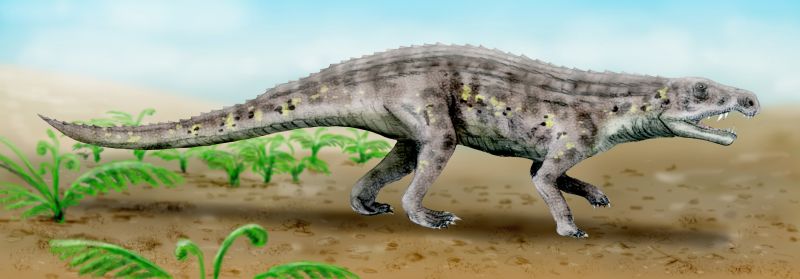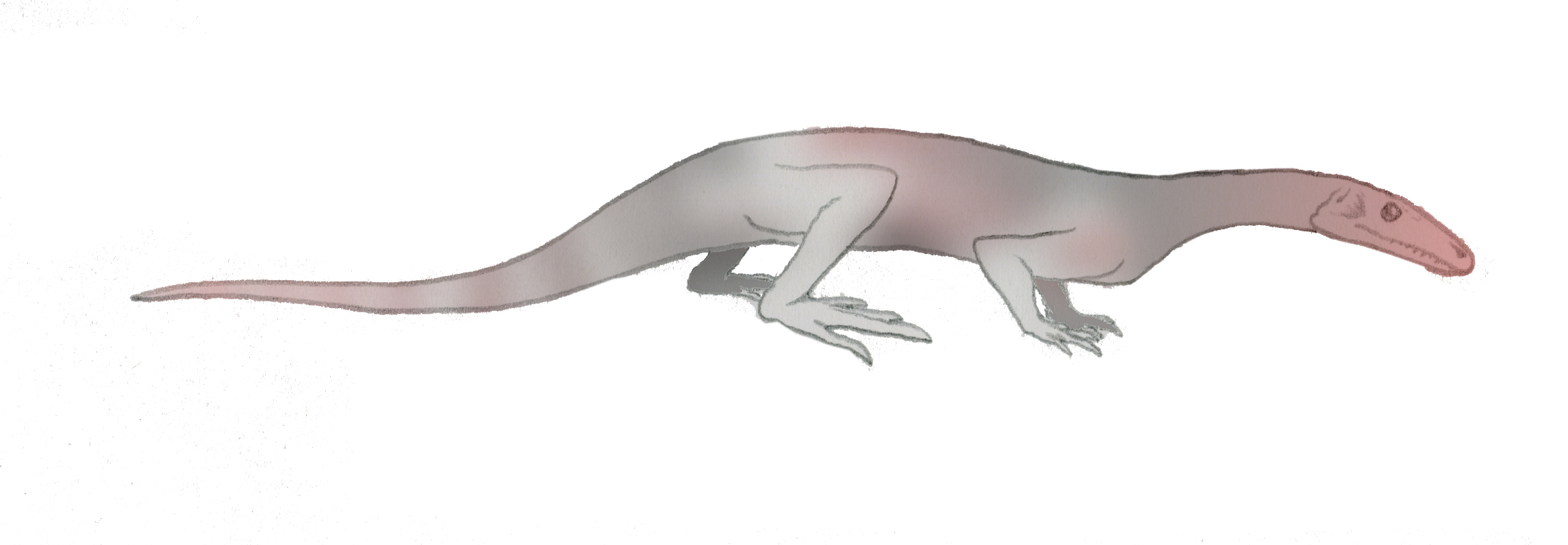|
Riojasuchus
''Riojasuchus'' is an extinct genus of Late Triassic ( Norian) quadrupedal archosaur. ''Riojasuchus'' is a member of Ornithosuchidae, a family of facultatively bipedal carnivores that were geographically widespread during the Late Triassic. Two other genera, ''Ornithosuchus'' and ''Venaticosuchus'', are currently known. The holotype specimen is PVL 3827. It was found in the Los Colorados Formation of the Ischigualasto-Villa Unión Basin in northwestern Argentina. Discovery and naming The holotype specimen is PVL 3827, consisting of a mostly complete crania and a partial postcrania. A majority of the postcranial material was preserved. The skeleton was found with others in the upper section of the Los Colorados Formation. Other than the holotype, it is known from three skeletons. Description The skull of the type specimen is long, and has a large, curved snout and short mandibles. Distinguishing characteristics Many characteristics were identified by Bonaparte in 196 ... [...More Info...] [...Related Items...] OR: [Wikipedia] [Google] [Baidu] |
Venaticosuchus
''Venaticosuchus'' is a genus of pseudosuchian archosaurs from the family Ornithosuchidae. Known from a single species, ''Venaticosuchus rusconii,'' this genus is described based on an incomplete skull and jaw (as well as a lost partial forelimb and osteoderms) collected from the Late Triassic (Carnian) Ischigualasto Formation in the Ischigualasto-Villa Unión Basin in northwestern Argentina, which was deposited around 230 million years ago. This fossil material has been termed the holotype specimen PVL 2578. ''Venaticosuchus'' incorporated a myriad of features present in the other two genera of ornithosuchids, ''Ornithosuchus'' and '' Riojasuchus''. However, it also had several unique traits, relating to the lower jaw. Reconstructions of the jaw musculature of ''Venaticosuchus'' showed that it had a slow, strong bite, similar to those of herbivorous aetosaurs such as ''Desmatosuchus''. ''Venaticosuchus'' and other ornithosuchids were likely specialized scavengers, due to ... [...More Info...] [...Related Items...] OR: [Wikipedia] [Google] [Baidu] |
Riojasuchus Skull
''Riojasuchus'' is an extinct genus of Late Triassic ( Norian) quadrupedal archosaur. ''Riojasuchus'' is a member of Ornithosuchidae, a family of facultatively bipedal carnivores that were geographically widespread during the Late Triassic. Two other genera, ''Ornithosuchus'' and ''Venaticosuchus'', are currently known. The holotype specimen is PVL 3827. It was found in the Los Colorados Formation of the Ischigualasto-Villa Unión Basin in northwestern Argentina. Discovery and naming The holotype specimen is PVL 3827, consisting of a mostly complete crania and a partial postcrania. A majority of the postcranial material was preserved. The skeleton was found with others in the upper section of the Los Colorados Formation. Other than the holotype, it is known from three skeletons. Description The skull of the type specimen is long, and has a large, curved snout and short mandibles. Distinguishing characteristics Many characteristics were identified by Bonaparte in 196 ... [...More Info...] [...Related Items...] OR: [Wikipedia] [Google] [Baidu] |
Riojasuchus BW
''Riojasuchus'' is an extinct genus of Late Triassic (Norian) quadrupedal archosaur. ''Riojasuchus'' is a member of Ornithosuchidae, a family of facultatively bipedal carnivores that were geographically widespread during the Late Triassic. Two other genera, ''Ornithosuchus'' and ''Venaticosuchus'', are currently known. The holotype specimen is PVL 3827. It was found in the Los Colorados Formation of the Ischigualasto-Villa Unión Basin in northwestern Argentina. Discovery and naming The holotype specimen is PVL 3827, consisting of a mostly complete crania and a partial postcrania. A majority of the postcranial material was preserved. The skeleton was found with others in the upper section of the Los Colorados Formation. Other than the holotype, it is known from three skeletons. Description The skull of the type specimen is long, and has a large, curved snout and short mandibles. Distinguishing characteristics Many characteristics were identified by Bonaparte in 1969. T ... [...More Info...] [...Related Items...] OR: [Wikipedia] [Google] [Baidu] |
1969 In Paleontology
Paleozoology Molluscs New bivalves Conodont paleozoology Vertebrate paleozoology Fish = New Actinopterygii ("ray-finned fish") = Archosauromorphs = Newly named crurotarsans = = Newly named dinosaurs = Data courtesy of George Olshevsky's dinosaur genera list. = Newly named birds = New Pterosaurs Synapsid Mammals Paleontologists * Death of Friedrich von Huene, the well known German paleontologist. References {{portal, Paleontology Paleontology Paleontology (), also spelled palaeontology or palæontology, is the scientific study of life that existed prior to, and sometimes including, the start of the Holocene epoch (roughly 11,700 years before present). It includes the study of fossi ... Paleontology 9 ... [...More Info...] [...Related Items...] OR: [Wikipedia] [Google] [Baidu] |
Los Colorados Formation
The Los Colorados Formation is a sedimentary rock formation of the Ischigualasto-Villa Unión Basin, found in the provinces of San Juan and La Rioja in Argentina. The formation dates back to the Norian age of the Late Triassic. The up to thick formation comprises sandstones, siltstones, mudstones and conglomerates with gypsum layers deposited in a fluvial to lacustrine environment. The formation is the uppermost stratigraphic unit of the Agua de la Peña Group, overlying the Lagerstätte of the Ischigualasto Formation. Los Colorados Formation is partly covered by the Cretaceous Cerro Rajado Formation, separated by an unconformity. The formation is known for its fossils of early dinosaurs, including the coelophysoid ''Zupaysaurus'' and the "prosauropods" ''Coloradisaurus'', ''Lessemsaurus'', and '' Riojasaurus''.Weishampel et al., 2004, pp.527-528 Magnetostratigraphic analysis suggests that the Los Colorados Formation was deposited between 227 and 213 million years ago.Kent et ... [...More Info...] [...Related Items...] OR: [Wikipedia] [Google] [Baidu] |
Ornithosuchus
''Ornithosuchus'' (meaning "bird crocodile") is an extinct genus of pseudosuchians from the Late Triassic (Carnian) Lossiemouth Sandstone of Scotland. It was originally thought to be the ancestor to the carnosaurian dinosaurs (such as ''Allosaurus''). However, it is now known to be more closely related to crocodilians than to dinosaurs. Description Despite this relationship to crocodiles, ''Ornithosuchus'' was able to walk on its hind legs, like many dinosaurs. However, it probably spent most of its time on all fours, only moving bipedally when it needed to run rapidly. Its skull also resembled those of theropod dinosaurs, but more primitive features included the presence of five toes on each foot and a double row of armoured plates along the animal's back. ''Ornithosuchus'' has traditionally been estimated at a length of about around . Classification A single species of ''Ornithosuchus'' is recognized, ''O. woodwardi''. ''Ornithosuchus taylori'' is a synonym.M. Belén von ... [...More Info...] [...Related Items...] OR: [Wikipedia] [Google] [Baidu] |
Prolacerta
''Prolacerta'' is a genus of archosauromorph from the lower Triassic of South Africa and Antarctica. The only known species is ''Prolacerta broomi''. The generic name ''Prolacerta'' is derived from Latin meaning “before lizard” and its species name ''broomi'' is in commemoration of the famous paleontologist Robert Broom, who discovered and studied many of the fossils found in rocks of the Karoo Supergroup. When first discovered, ''Prolacerta'' was considered to be ancestral to modern lizards, scientifically known as lacertilians. However, a study by Gow (1975) instead found that it shared more similarities with the lineage that would lead to archosaurs such as crocodilians and dinosaurs (including birds). ''Prolacerta'' is considered by modern paleontologists to be among the closest relatives of the Archosauriformes. History of discovery ''Prolacerta'' was first described by Francis Rex Parrington in 1935 from a single skull recovered near the small town, Middelburg, in the ... [...More Info...] [...Related Items...] OR: [Wikipedia] [Google] [Baidu] |
Proterosuchus
''Proterosuchus'' is an extinct genus of archosauriform reptiles that lived during the Early Triassic. It contains three valid species: the type species ''P. fergusi'' and the referred species ''P. alexanderi'' and ''P. goweri''. All three species lived in what is now South Africa. The genus was named in 1903 by the South African paleontologist Robert Broom. The well-known genus ''Chasmatosaurus'' is a junior synonym of ''Proterosuchus''. ''Proterosuchus'' was a mid-sized quadrupedal reptile with a sprawling stance that could reach a length of up to . It had a large head and distinctively hooked snout. It was a predator, which may have hunted prey such as ''Lystrosaurus''. The lifestyle of ''Proterosuchus'' remains debated; it may have been terrestrial or it may have been a semiaquatic ambush predator similar to modern crocodiles. ''Proterosuchus'' is one of the earliest members of the clade Archosauriformes, which also includes crocodilians, pterosaurs, and dinosaurs, includin ... [...More Info...] [...Related Items...] OR: [Wikipedia] [Google] [Baidu] |
Erythrosuchus
''Erythrosuchus'' (from el, ἐρυθρός , 'red' and el, σοῦχος , 'crocodile') is an extinct genus of archosauriform reptile from the Triassic of South Africa. Remains have been found from the Cynognathus Assemblage Zone of the Beaufort Group in the Karoo of South Africa. In the Late Triassic, the ecological niche left by ''Erythrosuchus'' was filled by archosaurs like ''Saurosuchus'' and ''Postosuchus''. Description ''Erythrosuchus'' was the largest predator of its time, and was around long. It walked on all fours and had limbs which were positioned semi-vertically under its body, unlike the more sprawling gait of most earlier reptiles. Its head was large and theropod-like, reaching a length of , and had sharp, conical teeth. ''Erythrosuchus'' was the largest erythrosuchid, but apart from its size, was largely similar in appearance to other related genera. It had a large head and comparatively short neck. One of the few distinguishing features of ''Erythrosuchus' ... [...More Info...] [...Related Items...] OR: [Wikipedia] [Google] [Baidu] |
Riojasaurus
''Riojasaurus'' (meaning "Rioja lizard") was a herbivorous sauropodomorph dinosaur named after La Rioja Province in Argentina where it was found in the Los Colorados Formation in the Ischigualasto-Villa Unión Basin by José Bonaparte. It lived during the Late Triassic (Norian stage) and grew to about long."Riojasaurus." In: Dodson, Peter & Britt, Brooks & Carpenter, Kenneth & Forster, Catherine A. & Gillette, David D. & Norell, Mark A. & Olshevsky, George & Parrish, J. Michael & Weishampel, David B. ''The Age of Dinosaurs''. Publications International, LTD. p. 41. . ''Riojasaurus'' is the only known riojasaurid to live in South America. Description ''Riojasaurus'' had a heavy body, bulky legs, and a long neck and tail. Its leg bones were dense and massive for an early sauropodomorph. In 2010 Gregory S. Paul estimated its length at and its weight at . By contrast, its vertebrae were lightened by hollow cavities, and unlike most early sauropodomorphs, ''Riojasaurus'' had fou ... [...More Info...] [...Related Items...] OR: [Wikipedia] [Google] [Baidu] |
Mesosuchus
''Mesosuchus'' ("middle crocodile") is an extinct genus of basal Rhynchosaur from early Middle Triassic (early Anisian stage) deposits of Eastern Cape, South Africa. It is known from the holotype SAM 5882, a partial skeleton, and from the paratypes SAM 6046, SAM 6536, SAM 7416 and SAM 7701 from the ''Aliwal North Euparkeria site''. ''Mesosuchus'' is quite small, spanning around 30 cm in length. ''Mesosuchus'' was discovered and named by David Meredith Seares Watson in 1912. Fossil discovery SAM 5882, the holotype for ''Mesosuchus'', consists of a partial rostrum, palate, braincase, lower jaws, sections of articulated presacral vertebral column, nine articulated caudal vertebrae, portions of scapula and pelvic girdle, and partial forelimb and hindlimbs. SAM 6046, one of the paratypes of ''Mesosuchus'', consists of an incomplete right maxilla, an articulated series of the last ten presacrals, both sacrals, and first six caudals, partial forelimbs, left and right pelvic g ... [...More Info...] [...Related Items...] OR: [Wikipedia] [Google] [Baidu] |
Proterochampsia
Proterochampsia is a clade of early archosauriform reptiles from the Triassic period. It includes the Proterochampsidae (e.g. '' Proterochampsa'', '' Chanaresuchus'' and '' Tropidosuchus'') and probably also the Doswelliidae. Nesbitt (2011) defines Proterochampsia as a stem-based taxon that includes '' Proterochampsa'' and all forms more closely related to it than ''Euparkeria'', ''Erythrosuchus'', ''Passer domesticus'' (the House Sparrow), or ''Crocodylus niloticus'' (the Nile crocodile). Therefore, the inclusion of Doswelliidae in it is dependent upon whether ''Doswellia'' and '' Proterochampsa'' form a monophyletic group to the exclusion of Archosauria and other related groups. Description Nesbitt (2011) found that Proterochampsians share several distinguishing characteristics, or synapomorphies. A prominent ridge runs along the length of the jugal, a bone below the eye. Another ridge is present on the quadratojugal, a bone positioned toward the back of the skull behind the j ... [...More Info...] [...Related Items...] OR: [Wikipedia] [Google] [Baidu] |









